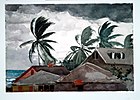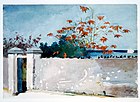Winslow homer
Winslow Homer (Boston, February 24, 1836 – Prouts Neck, September 29, 1910) was an American painter.
Biography
A self-taught artist, in 1857 he began working as a magazine illustrator, a regular contributor to Harper's Weekly. During the Civil War, Homer repeatedly visited the Virginia front where he would paint his first important oil painting, The Prisoners of the Front (1866, Metropolitan Museum of Art, New York), a notable work for his cool objectivity and vigorous realism.
In 1856 he moved to France for a year, but although his interest in the pictorial possibilities of natural light paralleled that of the early Impressionists, he was never directly influenced by Impressionism or French art.
In 1873 he began to use watercolor, a medium of expression as important in his work as oil. During the 1870s the predominant themes of his works were those of rural or idyllic inspiration: scenes of farm life, children at play, and scenes of well-known places populated by elegant women. Of the latter, the best known example is Long Branch, New Jersey (1869, Museum of Fine Arts, Boston).
The year spent in England (between 1881 and 1882), during which Homer lived in a fishing village, caused a definitive change in the subject matter of his work. From then on he concentrated on large-scale nature scenes, particularly scenes of the sea, of fishermen and their families. After establishing his solitary residence at Prout's Neck, on the Maine coast (where he would die on September 29, 1910), he produced masterpieces of realism such as Eight Bells (1886, Addison Gallery, Andover, Massachusetts). In this work, the drama of the marine scene is imbued with an epic and heroic quality that represents the dominant theme of his maturity: man's struggle with the forces of nature.
Starting in 1884, Homer spent many winters in Florida, the Bahamas, and Cuba, executing much of his plenairist work, especially watercolors or even speed painting, in a style that was very advanced for his time: fresh, loose, spontaneous, almost impressionistic, but without ever losing its basic relationship with American realism. He died in Prouts Neck, Maine on September 29, 1910.
Selection of watercolors from the MET
Contenido relacionado
Niels Bohr
Giovanni Battista Piranesi
Lorenzo Cerda







